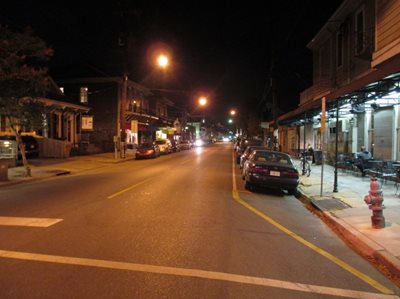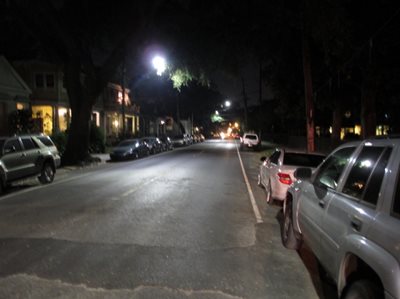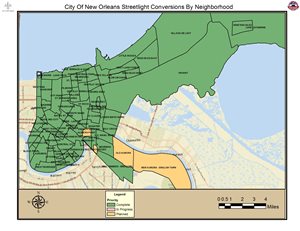Overview
The Department of Public Works oversees more than 54,000 streetlights, including those on Interstate highways and State roads. The streetlight system includes fixtures, poles, pole bases, wiring, circuitry, and junction boxes. It is comprised of 18 types of streetlight fixtures, 19 types of poles, 6 types of lamps, and 15 types of bulb wattages, including steel and concrete poles, residential lighting poles and fixtures, and a diverse collection of historical poles and fixtures.
In 2012, the City used one-time federal stimulus funding to convert over 41,000 streetlights to energy-efficient Light Emitting Diode (LED) lights. Over 75% of the streetlight system has already been converted.
LED streetlights reduce energy usage, reduce maintenance and operational costs, and improve system reliability. Benefits of energy efficient LED lights include:
- Design Life of 7-10 years versus to 2-3 years for conventional lights.
- Use 30-50% less energy versus conventional lights
- Provide the same or better level of illumination with a whiter hue light
- LED lights can be directed to illuminate specific areas

Traditional streetlights cast a yellow-tinted hue, as you can see above on Magazine St.

LED streetlights cast a white-tinted hue, as you can see the recently-converted lights on Magazine St.
On July 1, 2014, the City began a major streetlight upgrade and improvement initiative. A total of $16.4 million will be used to continue converting conventional streetlights to energy-efficient LED streetlights and perform needed capital repairs while a long-term, sustainable funding source is identified.
Streetlight Capital Improvement Program
Under this program, the City used $1.7 million in City Capital and Infrastructure Trust funding to perform permanent streetlight system upgrades and replacements including:
- Upgrading or replacing system infrastructure including conduits, conductors, upgrading or upsizing feed points, group relays, fixtures, and other capital improvements
- Rehabilitating streetlight pole components including painting of hardware components, and/or replacement/upgrade of pole components such as support arms, poles, bases or foundations
- Re-setting knocked down streetlights
- Installing new streetlight poles
The first priorities under this program are to improve street lighting along Interstate-10, Interstate-510 and Interstate-610, and upgrade critical system infrastructure to increase system reliability.

View a larger version of the conversion map by clicking here.
Frequently Asked Questions
How do I report a broken streetlight?
You may call 311 24 hours a day, 7 days a week to report a broken streetlight. The 311 Customer Service Agent will take down the nearest physical address of the streetlight, and issue you a ticket number. That ticket will then be sent to the Department of Public Works to assess. You may also report a streetlight outage online at https://nola311.org by filling out the request form provided. You will receive a ticket number when reporting an outage online and have the ability to check the status of the request utilizing this number.
What information do I need to report a broken streetlight?
When reporting a streetlight outage, please be prepared to provide the 311 Customer Service Agent your name and phone number in case additional information about your complaint is needed at a later date. Please also provide the nearest physical address of the streetlight, the pole number and the cross streets. Pole numbers are typically printed on metal plates affixed to the streetlight pole but may not be visible on each pole. Pole ID's are always alpha-numeric (For example AB123).
Who do I contact to request underground streetlight and traffic signal lines be marked in advance of construction?
The location of underground streetlights and traffic signals need to be marked by a certified professional. To have the lines marked, please contact the Department of Public Works 48-hours in advance. You may email dpw@nola.gov or call 504.658.8040 or 504.658.8067 to schedule markings.
This service is offered at no charge.
How do I get approval to hang banners on a city-owned streetlight?
The City of New Orleans’ Streetlight Banner Program is a policy that aims to raise awareness of and promote local civic and community events and occasions in a high-impact, place-based manner. Local organizations will be allowed to hang banners under certain conditions and specifications if first approved in writing by the City as detailed below. Banners, or other décor, may not be installed on City property without a permit. Requirements for banner placement on City property are here: Streetlight Banner instructions
What is the process for repairing a streetlight?
When a new service request is received from 311, the Department of Public Works does an assessment to determine what caused the outage and what will need to be done to fix the outage. Streetlight repairs typically take 2-3 weeks to repair. However outages due to underground problems can take longer.
When will my streetlight get repaired?
The Department of Public Works is currently addressing a backlog of approximately 700 streetlight outages. Streetlight repairs typically take 2-3 weeks to repair.
Streetlights needing major repairs, such as underground circuit adjustments, may take longer to address.
I've been waiting a long time. If I call 311 back, will my ticket get a higher priority?
No. Every call received by 311 generates a ticket in the system. The Department of Public Works then goes out to complete an assessment of the broken streetlight. In order to ensure a fair and equitable process, calling 311 or DPW does not speed the streetlight repair. The DPW assesses each streetlight and determines what repairs will be needed from that assessment.
How many streetlights does the city own?
The City of New Orleans owns over 54,000 streetlights. This number includes streetlights on the interstate, state and minor roads. The Department of Public Works is currently addressing a backlog of approximately 700 additional streetlight outages.
How many streetlight repairs are left?
The Department of Public Works is currently addressing a backlog of approximately 700 streetlight outages.
What money is budgeted for streetlight repair?
On July 1, 2014 the City began a major streetlight upgrade and improvement initiative totaling $16.4 million to continue converting conventional streetlights to energy-efficient LED streetlights and perform needed capital repairs while a long-term, sustainable funding source is identified. 85 percent of the streetlight system has been convereted to LED. Currently the city is using General and Bond funds to repair street light outages.
What are future plans for streetlight improvements?
The Department of Public Works has plans to standardize the streetlight system infrastructure. This change will allow repairs to be completed more rapidly. In the future, the Department of Public Works will upgrade and or move streetlight poles from areas that have high accident rates. Future plans for the streetlight system includes converting existing streetlights into LED energy efficient lights which last longer and require less electricity to operate.
How can I tell if my streetlight has already been converted?
LED streetlights appear flat and emit a white-tinted hue.